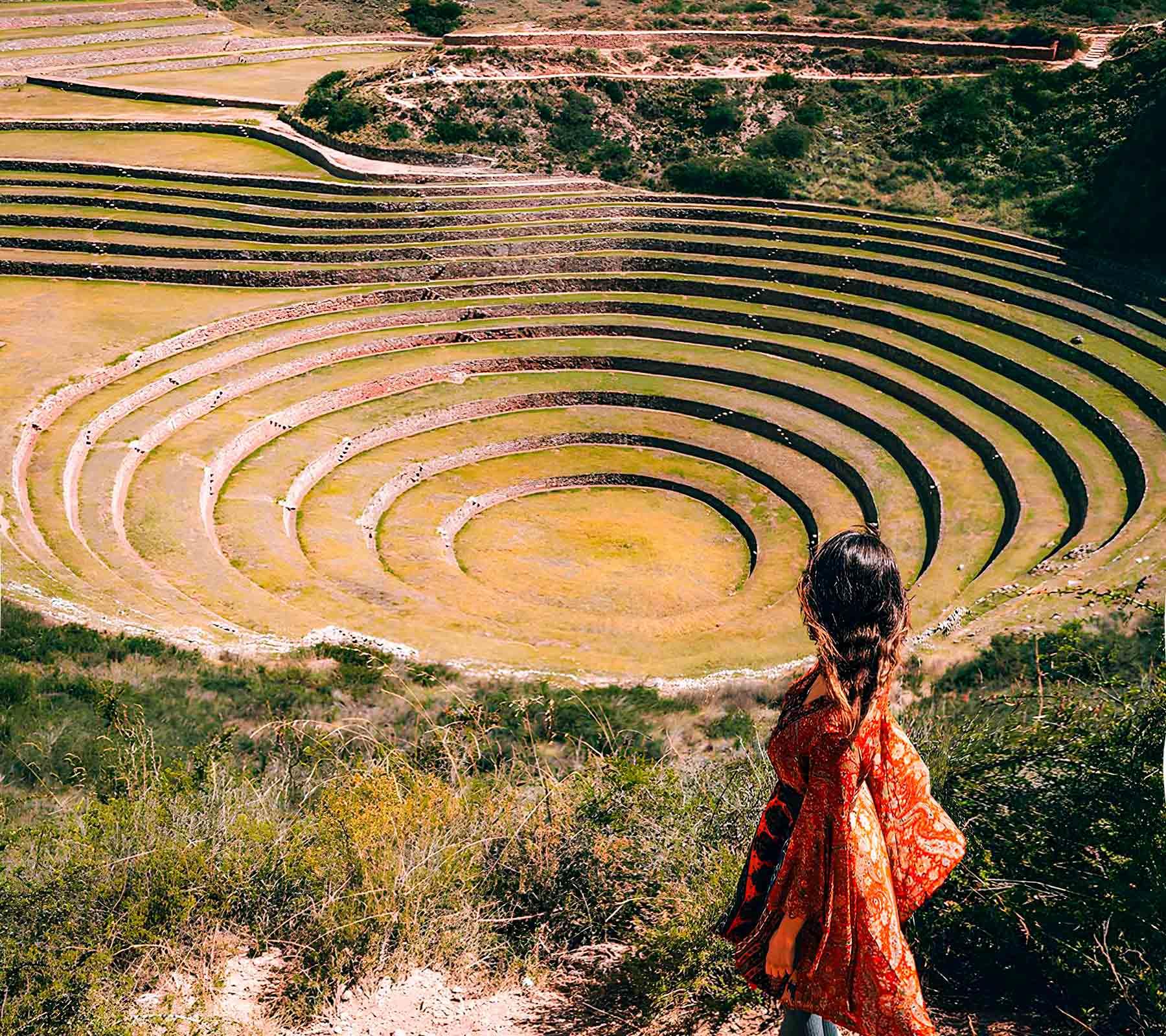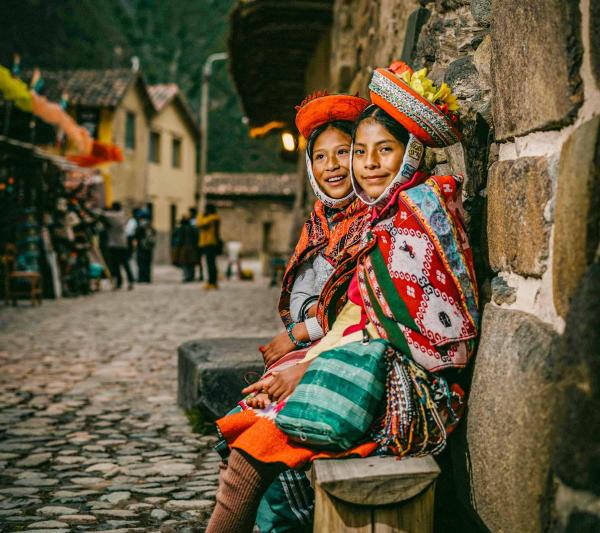These are terraces or agricultural platforms built in depressions or gigantic natural holes. These terraces are superimposed concentrically, taking the shape of a gigantic amphitheater. The largest hole has a depth of 150 m and the average height of the platforms is 1.80 m. According to historians, these constructions constituted an important agricultural laboratory of the Inca empire. Since their platforms are built with their respective irrigation channels and each of them constitutes a microclimate. What is striking is the great difference in average annual temperature between the top and bottom of the depressions, a difference that reaches up to 15°C.
Meaning of the name or Etymology:
The word Moray, not only due to the ancestral use that was given to it in the Inca era, but also due to similar words found in Spanish chronicles, is closely related to agriculture, more precisely to the harvest, given that the aforementioned words are Aymoray, which It was the name that the Incas gave to the month in which the harvest period occurred in the time of the Incas and in turn the moraya, a Quechua word in current use that is used to describe the dehydrated potato. Muyu, is another Quechua term that it resembles, this word means circle
Location:
Moray is located at 3,400 meters above sea level, between the territories of the communities of Kacllaraqay and Misminay, about 70 kilometers northeast of the city of Cusco and 7 kilometers from the town of Maras in the province of Urubamba.
Climate and temperature in Moray
As we constantly mention, the climate of the entire Cusco region corresponds to a single pattern, which is found in the rainy period between the months of November to April and in the dry and cold period between the period of May to October, without However, the climatic factor also strongly influences the temperature of the place, given that it is located on a plain surrounded by glaciers, which make the temperature generally cool and dry. The maximum temperature of the place is 18 degrees Celsius, which averages annually at 16 degrees Celsius, and the minimum temperature is -6 degrees Celsius, with an annual average of 0 degrees Celsius.
History of Moray
Before the Incas, this part of the Sacred Valley of the Incas was inhabited by the 'Maras' and 'Ayamarcas' ethnic group who occupied a large part of the current territory of the Sacred Valley of the Incas. After the Inca conquest, the construction of large buildings and platforms began in the territory of the Sacred Valley. This is how the Moray platforms were built, which were used by the Incas as an important agricultural control center. The production of the coca leaf, a plant considered sacred to the Incas, was carried out there. The investigations do not clearly specify whether during the colony (from 1532) the Moray platforms were worked. The truth is that only in 1932 did the Shirppe Johnson's expedition fly over the place, discovering the existence of the platforms, then covered by thick vegetation. During the 20th century, various investigations were carried out on Moray. Perhaps the most valuable of all was made by the anthropologist John Earls who established that it was an experimental agricultural center.
What am I going to see in Moray?
Beautiful landscapes – The set of platforms that make up Moray are visually beautiful to human eyes and, of course, to the lens of a camera. Many people come there to take the postcard photo and post it on their social networks. Circular platforms – The circular platforms of Moray were a very important place for Inca agriculture. It is believed that it was a center for experimental studies that the Incas used to plant products that could not be grown under other conditions. Adventure sports – There are tours to the platforms of Moray that include adventure on a bicycle or even an ATV. These services can be obtained at any tourism agency located in the Historic Center of Cusco.
What was the function of the Moray terraces?
According to research, during the Inca era of Tahuantinsuyo, Moray produced 60% of the total species of vegetables as well as more than 3 thousand varieties including potatoes, corn and many other species. For many years it was believed that Moray was caused by a meteorite that fell hundreds of years ago. However, the theory that suggests that a center of acclimatization and domestication of various plant species that were adapted for human consumption is currently accepted. The main plant species cultivated in Moray was the coca leaf, which is native to the hot regions of the Cusco jungle. The coca leaf was considered sacred by the Incas for its natural stimulant properties.
What products did they grow?
In Moray each agricultural terrace (1.90 meters high) had a certain temperature. At greater depths, the temperature increased. Thus, tuber production was very varied. Among the products that were worked in Moray, the following stand out: potatoes, goose, quinoa, kiwicha, pumpkin, coca leaf and other herbs for medicinal use.
How to go?
With a tour package – If you book an all-inclusive tour, the tourist transport service to Moray is already included. On your own – To go to Moray on your own you must take a tourist transport to the town of Chinchero. From there you must take a transport to the town of Maras, from where other transport services leave to the circular platforms of Moray.
Tips for your visit
If you are traveling on your own, buy the Cusco Tourist Ticket, which also includes a visit to the other tourist sites of the Sacred Valley of the Incas: Pisac, Chinchero and Ollantaytambo. In Moray it can rain at any time (especially from January to March), so it is advisable to bring a rain poncho.
Entrance fee to Moray
The entrance ticket to Moray is with the so-called 'Cusco Tourist Ticket', which costs 70 soles for foreigners and 40 soles for Peruvians. This ticket also includes entry to the archaeological sites of Ollantaytambo, Pisac and Chinchero. Does not include entry to the Maras Salineras. The Cusco Tourist Ticket can be purchased at the entrance gate of the Moray archaeological site. Also in the offices of the city of Cusco on Avenida El Sol 103 (historic center of Cusco).
What other places to visit?
The town of Maras – The town of San Francisco de Asís de Maras is 39 kilometers from the city of Cusco. Its beautiful colonial church stands out with canvases created by painters from the famous 'Cusco school'. Vehicles leave from there to Moray and the Maras salt mines. The Maras salt mines – The hundreds of natural salt wells that make up these salt mines are a sight to behold. It was used since the time of the Incas and continues to be marketed to this day by the local residents. Tours to Moray include a visit to these salt mines and the town of Moray.
Customs in Moray
Every October 8, hundreds of residents who live in the communities surrounding Moray go to the circular platforms in order to celebrate the 'Moray Raymi' or the 'Moray Festival'. This festival includes a show of folk dances related to the land, production, harvest and agricultural work. During that date, in addition to local residents, dozens of tourists visit the platforms of Moray to learn a little more about the Inca traditions represented there.






